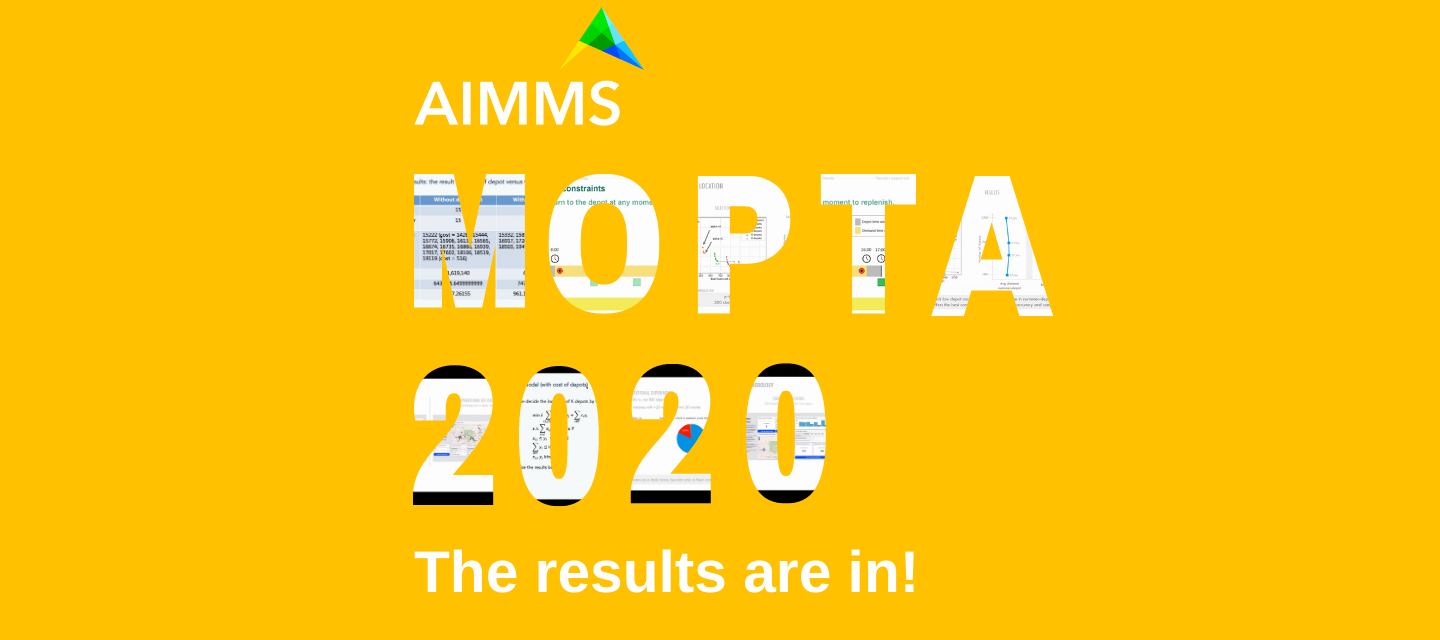The results of the 12th Annual AIMMS-MOPTA Optimization Modeling Competition are in! The competition took place virtually this year. We are very happy to share that all three of this year’s finalists solved the problem quite differently and went beyond what we expected, each solution very valid on its own. Congratulations are in order for Team NP Die Hard from University of Edinburgh, who won the competition this year.
About this year’s Problem Statement
When we were designing the problem statement with Dr. Boris Defourny, Assistant Professor at Lehigh University, we wanted to explore how mathematical optimization and machine learning approaches can work in tandem. Like always, the problem also had to be open-ended. It needed to have multiple correct solutions rather than one absolute solution. So, we settled on a Capacitated Vehicle Routing Problem with Time Windows (CVRP-TW) and added complexity by adding constraints or withholding data that is typically known in such problems to mimic a real-life business scenario - where all the data is not readily available and guesstimating missing data also becomes part of the problem.
We asked students to answer the following questions, given a network of nodes, their geographical distribution of daily demand for two calendar years, arcs which connect any two nodes, and the capacity of the vehicles:
- How many warehouses must be opened for this network and where?
- How many vehicles are needed at each warehouse?
- What will be delivery route for each vehicle on each day?
We start with a warehouse location problem, which is a long-term strategic decision that involves large capital and then steps into a relatively smaller decision surrounding the fleet size. You can purchase or sell a vehicle fairly easily, but moving the entire infrastructure related to a distribution warehouse is not that straightforward. Finally, we have a problem that deals with daily operations at each warehouse. In a typical facility location problem, you are given some candidate locations from which you must pick the final locations using a MIP model, but we did not provide any candidate locations here.
The Teams
Team MαD Condors from Universidad de los Andes presented a novel stochastic programming approach which considers how demand could present itself beyond the two years to identify locations for warehouses. Team Go Blue’s (University of Michigan) approach did not have a MIP model at all (pleasantly surprising), yet they had a complete solution using only algorithms such as k-means and heuristics - like the Clarks-Wright savings heuristic. Eventual winners, Team NP Die Hard from University of Edinburgh used a combination of k-medoids and multiple MIP models. All three teams also analyzed the demand data to find patterns and construct cases to simulate the performance of their approaches.
It was a very tough decision to choose only one winner. We appreciate the efforts put in by all three teams. We hope this year’s competition provided them valuable experience in breaking down large problems into smaller sub-problems and helps them further their careers. While I, as co-organizer, was disappointed to not visit the beautiful Lehigh Valley again this year, I am thankful to our colleagues at Lehigh University who made it possible for the competition to go forward virtually. If you are curious about the teams and their solutions, take a look at the videos below. For now, until next year.
Team MαD Condors presentation
Universidad de los Andes
Team members: María José Consuegra, Alfaima Solano, and David Corredor
Advisor: Camilo Gómez, PhD
Team Go Blue presentation
University of Michigan
Team members: Jiaqi Guo and Bin Yao
Advisor: Prof. Viswanath Nagarajan
Team NP Die Hard presentation
University of Edinburgh
Team members: Paula Fermin, Ivona Gjeroska, and Albert Sola
Advisor: Prof. Miguel Anjos
Watch the full playlist on YouTube. If you want to try to solve the problem yourself, you can download the problem statement and data from here: https://coral.ise.lehigh.edu/~mopta/competition#


